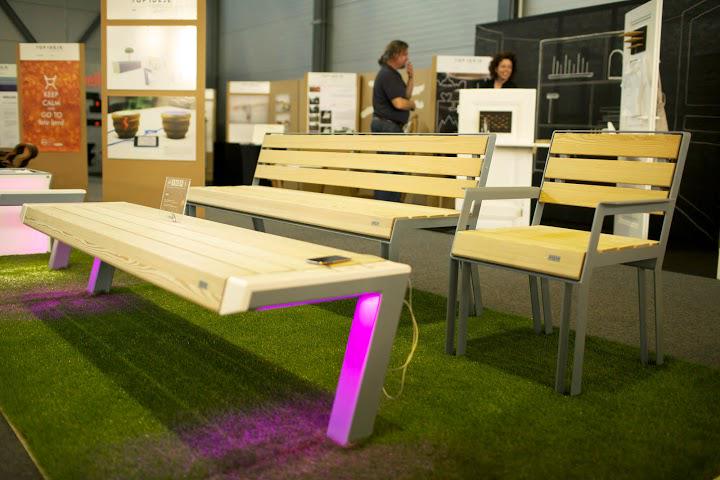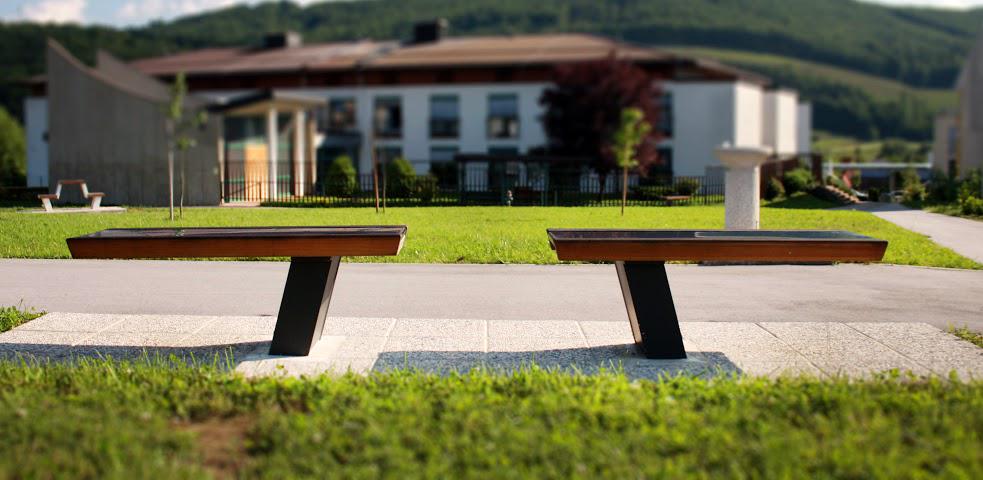
The urban furniture is a segment we are certain has potential.

The Moment urban furniture, presented by young designers and architects, stood out with their fresh ideas at the Top Ideas trade show, organized at the Ambient Ljubljana Furniture Fair. It stood out quite prominently, as it was awarded one of the five equivalent TOP FIVE awards by the international committee.
Street benches, poles, lightings and flower troughs are perfected not only by design, but also technologically. Clean, plain lines are complemented by the element of energy, as they allow charging of mobile phones, provide wireless access to internet (Wi-Fi); touch, all the items have lights installed, which allow the user to change the intensity and colour by hand movements, and connection, as the lighting systems are interconnected into an interactive network.
Precise, and selective
The main theme which brought together industrial designers Domen Gregorič (24), Jan Ravber (25) and the soon to be doctor of electronic Gregor Logar (26) was development of technologically innovative and visually perfected products. As the boys are extremely "precise and picky", as they say, they chose the name Aklih (meaning ‘choosy’,’ picky’, even ‘pernickety’). They used that name for the first time at the Ambient Furniture Fair; besides the TOP FIVE award for their lights and Wave speakers, created with a 3-D printer, they won also the TOP IDEA award.
Field research
"The urban furniture is a segment we are certain has potential," Domen explains, and adds that benches created by the Aklih group in their basic version have already been included into urban furnishing in Trebnje, Mokronog and Mirna. "One of our ideas was to have charging stations for mobile phones throughout the city, besides which you would be able to sit. The cordless charger is built into the bench, therefore you only need a connector for wireless charging, or you simply use the phone's charging cable to connect it with USB port." The scheme of the Moment urban furniture started to emerge less than two years ago, and the boys from Mirna na Dolenjskem approached the project in all seriousness. They visited the countries of Benelux and looked at the urban furniture there.
"We rented bikes, and rode through the centres of Amsterdam, Eindhoven, Brussels, Kortrijk and Bruges. We attracted some strange looks by measuring benches and looking at them from every possible side - which is rather normal, as nobody is really interested in what he is sitting on," Jan laughs at the memories.
Innovativeness
When creating the Moment urban furniture, made of durable Siberian larch and of metal framework, they also thought about making life easier for architects furnishing a city, or a park. "In this way architects don't have to use products of ten different manufacturers, with different designs of elements of the urban furniture, e.g. benches, flower troughs, garbage cans, all kinds of lights, or bicycle sheds and railings. All the elements are either basic, or advanced. One of the systems is, for example, lighting which you can control by touch, either individually or through the internet network, which means the light can follow the user through the park, or the entire park can be lighted with the same colour spectre."
In designing the lighting, consisting of modular 10-W LED lights, they followed the provision of the legal regulation on the limit value of the lighting. "All the glasses are flat, and thus do not pollute the environment. It was the reason we had to change the optics, and the solution is very innovative, as it is very difficult to illuminate the surroundings from the height of 40 cm through flat glass."
Both feet on the ground
The responses to the Moment urban furniture were good. "We have already received two orders from Slovenia, from private clients who wish to have these items at their homes. Now we will be able to test them, and see how it works in practice," Domen says, and he does not hide their embarrassment because the happenings after the Ambient Fair actually came too soon. "Presently we are still working on our marketing strategy."
Most of the start-up capital to start the production will be theirs, with the help of their families and friends. "We have no intention of purchasing machines for production, as being industrial designers we intend to work on projects for different companies. We already have some products, namely the speaker, the lights, and the bird feeder produced with a 3D-printer. This investment will be a bit more substantial, as 3D-printers allow production of a small series of products, and in this way you can make a prototype by yourself," Domen explains. For now they have two wood printers; one printer needs ten hours to produce lights, or a speaker.
The urban furniture is a segment we are certain has potential.

































































